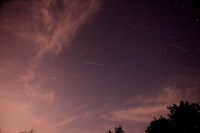 |
INDEPENDENCE DAY IRIDIUM FLARE
Iridium Flare from Iridium Satellite 66. Photo taken 2011 July 4 at 01:43:15 UT. Predicted Magnitude 0. Airplane trails appear below and to above right of satellite trail. Location: North of Kanapaha Prairie, S.W. Gainesville, Florida. . Photo Details: Canon EOS Mark II, ISO 6400, 20s, f/4.5, FL=20 mm.
|
|
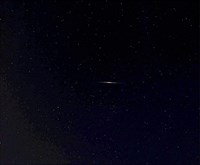 |
BRIGHT IRIDIUM FLARE
Exceedingly Bright Iridium Flare from Iridium Satellite 21. This was an exceptionally bright flare that probably exceeded the brightness of Venus by about twenty-five times! Photo taken 2011 July 5 at 01:37:12 UT. Predicted Magnitude -8. Location: Paynes Prairie US441 Overlook, Gainesville, Florida (29°34'27.26"N, 82°20'03.06"W; elevation 60 ft. or 18 m). Photo Details: Canon EOS Mark II, ISO 800, 20s, f/5.6, FL=21 mm.
|
|
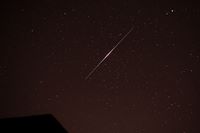 |
ANOTHER VERY BRIGHT IRIDIUM FLARE
Another Exceedingly Bright Iridium Flare from Iridium Satellite 83. Despite lights from Archer Rd. in Gainesville, Florida and I-75, clear skies Tues. evening, 2017 Jan. 24, allowed imaging a brilliant flare from Iridium Satellite 83. Photograph taken from front of S.W. Gainesville suburban home. Satellite passed over N.E horizon 7:26:08 p.m. EST moving downward toward northern horizon over house roof.
Gradual brightening and dimming of flare visible for about five seconds. Predicted peak brightness magnitude -8, about 25x brighter than current brightness of Venus (mag. -4.5). Estimated maximum brightness less, about magnitude -5 (?). Peak brightness lasted only about a second, so estimating magnitude difficult. In addition, the north sky bright from lights on Archer Rd. and intersection with I-75. Still, amazing! (Also see photos below.)
PHOTO DETAILS: Canon DSLR EOS 5D II with Canon 50mm f/1.8 lens; tripod mounted. Exposure 30 sec at f/2.5, ISO 500 (Post processed; slightly trimmed). Date/Time: 2017 January 24, from 7:25:53 to 7:26:23 p.m. EST. Location: Suburban S.W. Gainesville, Florida.
Flare and Iridium Satellite 83 Details Here
|
|

Photo 1: January 29
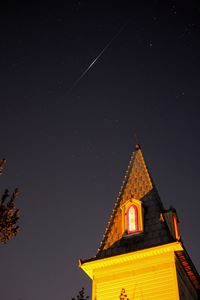
Photo 2: January 30
|
THREE SUCCESSIVE IRIDIUM FLARES
Three Iridium Flares in Three Days. From 2017 Jan. 29 to 31, three Iridium flares passed through nearly the same part of the northern sky at about the same evening time moving downward toward the northern horizon (similar to above flare of 2017 Jan. 24.) The first flare was moderately bright, the latter two flares very bright.
All Picture Locations: Historic Kanapaha Presbyterian Church, 6221 SW 75th Terrace, Gainesville, Florida.
PHOTOS:
- 2017 Jan. 29, 19:04:42 EST, Iridium Satellite 53, Predicted Peak Mag. 0
(Altitude 58° Azimuth 30°)
- 2017 Jan. 30, 18:58:33 EST, Iridium Satellite 54, Predicted Peak Mag. -8
(Altitude 58° Azimuth 33°)
- 2017 Jan. 31, 18:52:25 EST, Iridium Satellite 83, Predicted Peak Mag. -8
(Altitude 60° Azimuth 33°)
PHOTO DETAILS:
Camera: Canon DSLR EOS 5D II, tripod mounted, 30 sec exposure times.
Photo #1: Canon 50mm f/1.8 lens. Exposure f/4.5, ISO 400, from 19:04:27 to 19:04:57 EST
Photo #2: Canon 50mm f/1.8 lens. Exposure f/4.5, ISO 250, from 18:58:18 to 18:58:48 EST
Photo #3: Canon 20-35 mm, f/3.5-4.5 lens at 20 mm. Exposure f/4.5, ISO 250, from 18:52:10 to 18:52:40 EST
Photo #4: A trimmed and enlarged section of Photo #3.
Click photos for larger size.
|

Photo 3: January 31
|

Photo 4: January 31 (Enlarged)
|
|
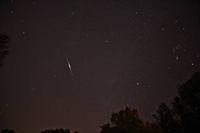
Click to Enlarge in New Window
Then Click Image to Sequence Through Labeled Versions.
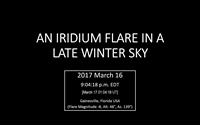
"An Iridium Flare
in a Late Winter Sky"
(A Brief MP4, 4-min. Movie
Identifies Sky Objects)
|
EXCEEDINGLY BRIGHT IRIDIUM FLARE IN WINTER SKY
Exceedingly Bright Flare From Iridium Satellite 11 Pops Out of Sky Like A Blazing Point of Light! Peak brightness (predicted mag. -8) lasted for about a second. (Predicted time 9:04:18 p.m. EDT or 01:04:02 UT on March 16). Entire flare event lasted for perhaps ten sec. Orion is clearly visible on right side of photo with belt pointing at Sirius. In fact, thirteen constellations appear with several bright stars. Procyon shines to upper left of Sirius (and to the upper right of flare.) Regulus appears toward the upper left corner of the photo along with some stars in Leo's "sickle." Faintest stars are about mag. +9. The flare appeared in the faint constellation of Hydra ("The Water Snake"). Even so, photo clearly shows outline of "snake" with Alpha Hydrae to lower left of flare and Hydra's head (just to upper right of the flare). (Tree silhouettes appear at bottom of photo.)
Click photo for larger size to better see flare and stars. Then click each image to sequence through labeled images with Constellations and Stars, then Deep Sky Objects and finally Deep Sky Objects Enlarged from Original Photo.
Also see short (4-min.) MP4 movie that also displays the constellations and star identifications. (Give it a moment to load.)
Flare events like this will become rare since the existing Iridium satellite network is being replaced by a new network of communication satellites that will probably not show bright flare events.
PHOTO DETAILS: Date/Time: 2017 March 16, from 9:04:02 to 9:04:32 p.m. EDT. Location: Suburban S.W. Gainesville, Florida.
Camera: Canon DSLR EOS 5D II with Canon 20-35 mm, f/3.5-4.5 lens at 20 mm. Exposure 30 sec at f/3.5, ISO 1600.
|
|
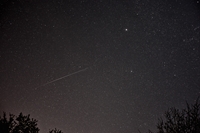
A "Faint" Flare
Capella at Upper Rt.
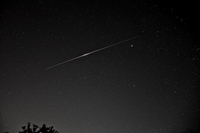
A Very Bright Flare
Capella to Rt. of Flare
Faint Airplane Trail Below Flare
(Click to enlarge Photos)
|
IRIDIUM FLARES — GONE FOREVER?
Are Iridium Flares Disappearing? Iridium flare events will likely become rare and more unpredictable as the original set of Iridium satellites is decommissioned. (See note below.) So, see them before they disappear from night skies. These flares, arriving exactly where and when predicted, can be very surprising and startling if you do not know their nature, especially if the flare is extremely bright.
Here are photos of two Iridium flares, taken 2019 January. The pictures show these satellites still flare. The first is only moderately bright and the second exceptionally bright (predicted peak magnitudes -1 and -8, respectively). The first was not easily visible to the naked eye, especially with bright moonlight. Still, the flare is easily visible in first photo. The second flare, five days later, was extraordinarily brilliant though the sky was also bright with moonlight. Both appeared in the same part of the sky north (left in photo) of Capella in Auriga. Limiting magnitude in each photo approx. +11.
Note: A used SpaceX Falcon 9 rocket lifted the final Iridium Next satellites into orbit 2019 January 11. This completes the constellation of the next generation of 75 Iridium satellites replacing the original, aging set of 66, first launched in 1997.
Photo Details: Canon DSLR EOS 5D II with Canon 50 mm f/1.8 lens on iOptron StarTracker Mount.
Picture 1: Iridium Satellite 32. 2016 Jan. 16 7:38:08 p.m. EST, 30 sec at f/3.5 (ISO 800)
Picture 2: Iridium Satellite 58. 2016 Jan. 21 7:16:27 p.m. EST, 46 sec at f/3.5 (ISO 640). Both pictures slightly trimmed from original.
|
|
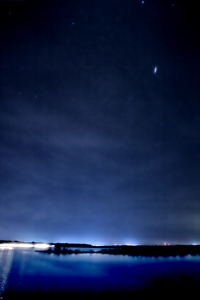
Click to Enlarge

Labeled Version |
VERY BRIGHT IRIDIUM FLARE OVER PAYNES PRAIRIE
Bright Flare Breaks Through Clouds.
Curious if any of the original Iridium satellites would still flare? Iridium 97 was predicted to produce a very bright flare evening of Feb. 13, 2019 from the Paynes Prairie US 441 Ecopassage Observation Boardwalk Overlook south of Gainesville, Florida. A passing cold front produced cloudy skies but the clouds had a sharp northern edge. Would the clouds pass through by the time of the flare event? Unfortunately, the only area with clear skies was in the west though some partial clearing occurred toward the south. However, the flare location was in the northern sky. Without stars as a guide, camera was pointed to the north without knowing precise location of flare.
As the time of the flare approached, little hope remained for seeing anything. Usually one can spot the Iridium satellite brightening some seconds before the flare but nothing was seen.
But then, miraculously, the satellite flared so brightly that its brilliant light broke through partially clearing skies! In addition, somehow the camera was pointed in the right direction to capture the flare. The flare trail is short since clouds hid most of the dimmer parts of the flare's track.
See picture. Can you also see some stars shinning through clouds? This includes bright Capella (Alf Aur) at the top with Menkalinan (Bet Aur) to the right. To the left of Capella and slightly down is Mirfak (Alf Per) with Gamma Persei below and Almach (Gam And) near the left edge. Midway down the left edge are three stars from Cassiopeia (left side of the well-known "M") that consist (left to right) of Schedar (Alf Cas), Caph (Bet Cas) and Gamma Cassiopeiae. Sharp eyes might also spot faint appearing Eta Cassiopeiae just to the right of Schedar. If you need help, see the labeled version.
Lights from Gainesville, Florida appear across the northern landscape at bottom with car headlights from US 441 at lower left. In the foreground is Paynes Prairie State Preserve flooded with lingering waters. Finally, look carefully at lower right and you can see lights from American Airlines Flight 5329 arriving from Charlotte and landing at the Gainesville Airport at 7:16 p.m. EST!
So, Iridium flares were not quite over yet at the time this photo was taken.
Photo Details:
Date: 2019 Feb. 13
Camera: Canon DSLR,EOS 5D Mark II; Canon 20-35 mm lens; f/3.5-4.5 USM at 20 mm; White Balance on Auto. Camera on fixed mount.
Exposure: 46 sec beginning 19h09m59s EST, at f/8, ISO 200.
|
|
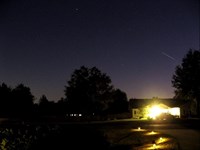 |
INTERNATIONAL SPACE STATION
Flyby of International Space Station with Space Shuttle Endeavor (STS-126). Click to enlarge, see constellation and star identification and see animation. Or go direct to Animation. Location: Gainesville, FL (2008 Nov. 17). Photo Details: Canon Powershot A710 IS
Three 15 sec exposures at f/2.8; ISO 400; Focal Length 5.8 mm (Equivalent to 35 mm with 35 mm Film).
|
|
 |
LAUNCH OF STS-115: ATLANTIS
Launch of Atlantis (STS-115) on 2006 Sept. 9 This launch left a contrail as seen from S.W. of Gainesville, Florida. Although 129 miles from Cape, shuttle launches from North Central Florida are often spectacular. Distance to Cape = 129 mi. Camera: Canon Powershot A710.
|
|
 |
LAUNCH OF STS-117: ATLANTIS
Launch of Atlantis (STS-117) on 2007 June 8 at 7:41 pm. EDT. Sunlight glints off shuttle for a moment. Seen from S.W. of Gainesville, Florida. Distance to Cape = 129 mi. Photo Details: Canon Powershot A710, Lens 5.8-34.8 mm at 17.2 mm. 1/320s at f/4; ISO Equiv. 100.
|
|
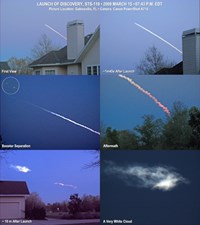 |
LAUNCH OF STS-119: DISCOVERY
Launch of Discovery (STS-119) on 2009 March 15. Six views from about 7:45-7:55 p.m. EDT including one showing booster separation. Seen from S.W. of Gainesville, Florida. Distance to Cape = 129 mi. Camera: Canon Powershot A710, Lens 5.8-34.8 mm at various focal lengths and exposures. ISO Equiv. 400.
|
|
 |
LAUNCH OF STS-129: ATLANTIS
Launch of Atlantis (STS-129) on 2009 November 16. At about 2:30 p.m. EST, this launch left a beautiful contrail. Seen from S.W. of Gainesville, Florida. Distance to Cape = 129 mi. Photo Details: Canon DSLR EOS 5D II, Lens EF 100-400, f/4.5-5.6L IS USm at 390 mm. 1/2000s at f/11; ISO Equiv. 400.
|
|
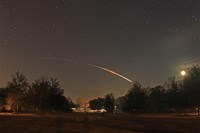 |
NIGHT LAUNCH OF STS-130: ENDEAVOR
Night Launch of Endeavor (STS-130) on 2010 February 8. This nighttime launch produced a spectacular trail across early morning sky at 4:16 a.m. EST. Waning gibbous moon rises over southwest horizon. Seen from S.W. of Gainesville, Florida. Distance to Cape = 129 mi. Photo Details: Canon DSLR EOS 5D II, Lens EF 25-135, f/3.5-5.6 IS USM at 28 mm. 105 sec at f/5.6; ISO Equiv. 800.
|
|
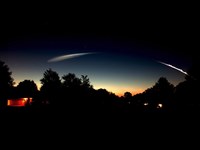 |
PREDAWN LAUNCH OF STS-131: DISCOVERY
Predawn Launch of Discovery (STS-130) 2010 April 5. This launch just before sunrise left an amazing and incredible contrail trail at 6:23 a.m. EDT across early morning sky. See next image for enlargement. Bright star rising (lower right) is Jupiter. Seen from S.W. of Gainesville, Florida. Distance to Cape is abt. 137 mi. Photo Details: Canon DSLR EOS 5D II, Lens EF 25-135, f/3.5-5.6 IS USM at 28 mm. 192 sec at f/8; ISO Equiv. 800. On spaceweather.com (2010-07-09&10)
|
|
 |
AMAZING CONTRAIL OF STS-131: DISCOVERY
Amazing Contrail from the Predawn Launch of Discovery (STS-130) 2010 April 5. An extraordinary contrail across the early morning sky (6:23 a.m. EDT) can be seen in this enlargement from the previous picture. Observed from S.W. of Gainesville, Florida. Distance to Cape is abt. 137 mi. Photo Details: Canon DSLR EOS 5D II, Lens EF 25-135, f/3.5-5.6 IS USM at 28 mm. 192 sec at f/8; ISO Equiv. 800.
|
|
 |
NIGHT LAUNCH OF SPACEX STP-2 MISSION
Booster Separations and Exhaust Plumes 2019 June 25. This short time lapse exposure captures a 30-sec glimpse of the SpaceX STP-2 launch including the Falcon Heavy rocket, booster separations and exhaust separation plumes beginning 2:33:30 a.m. EDT (3m30s after liftoff). An overexposed, bright last quarter moon is at lower left. Stars show short streaks due to 30 sec exposure time. Observed from S.W. of Gainesville, Florida. Distance to Cape is abt. 140 mi. so objects appear low (abt. 15° high) over ESE horizon.
Photo Details: Canon DSLR EOS 5D II, Lens EF 25-135, f/3.5-5.6 IS USM at 41 mm. Exposure 30 sec at f/4; ISO Equiv. 800. Imaged processed and trimmed from original.
|
|

(Click to Enlarge)
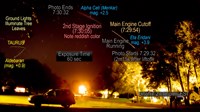
Annotated Version
(Click to Enlarge)
|
NIGHT LAUNCH OF SPACEX CREW-1 MISSION
Spectacular Night Launch Seen From Gainesville, 2020 November 25. Sixty second time lapse exposure captures stages in the launch of the SpaceX Crew-1 launch with four astronauts.
Liftoff: 7:27:17 p.m. EST. Exposure Starts: 7:29:32 p.m.
Main engine Shutdown: 7:29:54 (gap in trail).
Second Stage Ignition: 7:30:05 p.m. (reddish contrail).
Exposure Ended: 7:30:32 pm.
Stars show short streaks due to 60 sec exposure time. Observed from S.W. of Gainesville, Florida. Distance to Cape abt. 140 mi. so objects appear low (abt. 20° high) over eastern horizon. Bright streaks at upper left are tree leaves illuminated by ground light. Eta Eridani (mag. +3.9) appears above main engine burn. Menkar or Alpha Ceti (mag. +2.5) appears just above reddish second stage burn. The Hyades in Taurus with Aldebaran appear below leaves on left. See annotated version.
Photo Details: Canon DSLR EOS 5D II, Lens EF 28-135, f/3.5-5.6 IS USM at 28 mm. Photo slightly trimmed from original. Exposure 60 sec at f/3.5; ISO Equiv. 800.
|
|

(Click to Enlarge)
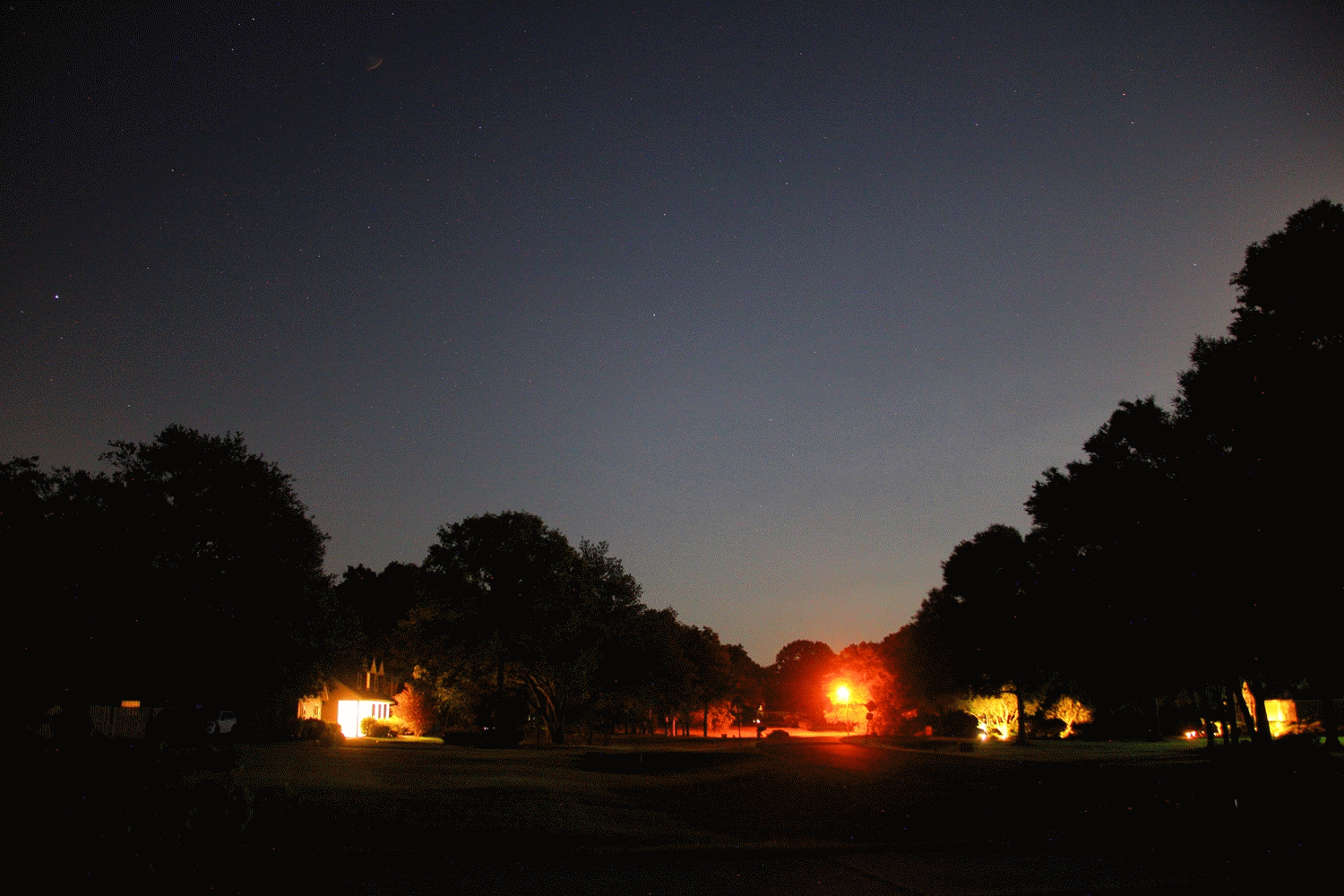
GIF Animation
(Click to Enlarge)
|
SPACEX FALCON 9 LAUNCH
Sixty Starlink Satellites Lifted into Orbit 2020 April 28. Launched 11:44 p.m. EDT from Cape Kennedy, Pad 40, 140 miles away, the rocket could be seen from Gainesville, Florida crossing the eastern sky including main engine cutoff. Moon was 94% illuminated (Altitude 16°, Azimuth 127°) behind trees on right. Vega appears on left side. The bottom of the Hercules "Keystone" borders top left. Ophiuchus is center middle and right. An airplane trail crossed during the field of view during launch.
First Image shows time lapse from 11:45:53 TO 11:49:56 p.m. EDT (so stars show trails).
Second Image is a GIF Video during this same time interval showing the spacecraft moving across the sky (right to left) and the air plane (moving left to right). An MP4 Video is also here.
Photo Details: Canon DSLR EOS 5D II, Lens EF 28-135, f/3.5-5.6 IS USM at 28 mm. Exposures 1/4 sec at f/3.5 with approximately one second delay between frames; ISO Equiv. 1600.
|
|

(Click to Enlarge)
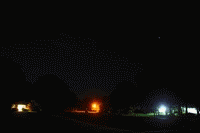
GIF Animation
(Click to Enlarge)
|
SPACEX CREW-2 LAUNCH
SpaceX Crew-2 Launch from Cape Kennedy 2021 April 23. Spectacular early morning launch as seen from Gainesville, Florida, 140 miles northwest of Cape Kennedy. Launch at 5:49 a.m. EDT or 12 minutes before nautical twilight began. (Sunrise at 6:55 a.m. EDT.)
Photo looks east with Jupiter (mag. -2.2) appearing at upper right. The rocket's plume in this photo appears just to the upper right of the "Great Square of Pegasus."
Photo Details:
Time: 5:52:41 a.m. EDT
Camera: Canon DSLR EOS 5D II on fixed mount
Lens: EF 28-135, f/3.5-5.6 IS USM at 28 mm
Exposure: 10 sec at f/3.5, ISO 400
Second Image: Short GIF Animation
from 5:56 to 5:59 a.m. EDT showing the spacecraft moving across the sky (right to left). Frames every 10 sec.
Also available as more detailed MP4 Video here or on YouTube.
|
|
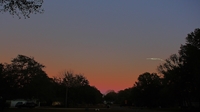
(Click to Enlarge)
|
SPACEX FALCON HEAVY LAUNCH
National Security Space Classified Launch: USSF-67 to Geosynchronous Orbit 2023 January 15
as Viewed From S.W. Gainesville, Florida. Launches may not be an impressive spectacle as when viewed from near the Cape. However, they can still be interesting from a distance. This launch from about 140 miles distance proved disappointing apparently because the trajectory headed eastward over the Atlantic Ocean. Still it proved an interesting sight. Photo shows rocket trail with booster separation. A time lapse video of this launch seen from Gainesville, Florida is on YouTube.
Photo Details: Canon DSLR EOS 5D II, Lens EF 20-35 mm, f/3.5-4.5 USM at 35 mm. Exposures 1/60 sec at f/6.7, ISO Equiv. 400.
|
|
|